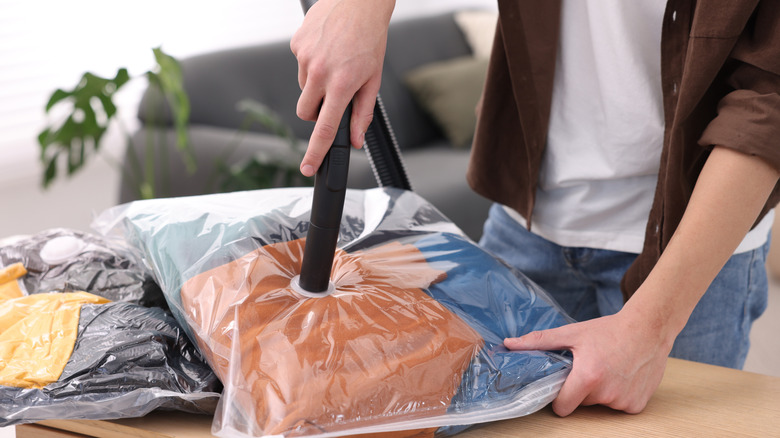
The vacuum seal packing trend has taken over travel feeds across social media, marketed as the ultimate space-saving solution. The premise sounds genius: Suck the air out of your clothing with a vacuum or hand pump to compress bulkier items into a fraction of their original size to get more space in your luggage. But in practice, this viral packing trick can create more problems than it solves.
Wrinkles are the first major downside. Clothes are compressed tightly with no airflow, so most garments
will come out looking like crumpled napkins. You're left with two options: waste precious vacation time ironing each morning or rock the "I slept in this" look all vacation long. The latter might be fine for a road trip wardrobe, but not for vacation photos, business travel, or that destination wedding you booked. That said, mid-range to upscale hotels almost always provide an iron and ironing board, but budget hotels and motels may not.
Also, vacuum-sealed bags may help you fit more volume into your suitcase, but they do nothing to reduce its weight. In fact, given that you're now able to pack more items, you're much more likely to exceed airline weight limits. Most major U.S. airlines charge $100 to $200 for overweight checked bags, which start at just 50 pounds for economy class. But there's an exception: lightweight but bulky outerwear like parkas, ski jackets, and down coats. These items generally don't weigh much, so you're less likely to go over airline limits. In this case, a vacuum bag can free up major space.
Read more: How To Pack Just One Carry-On For A Week-Long Vacation
Vacuum-Sealed Bags Make Travel More Stressful And Less Sustainable Than You Think

Vacuum-sealed bags may compress well, but another major drawback is trying to get to your stuff. Need a sweater for a chilly airport lounge or a quick outfit change after spilling a drink? Time to unpack and reseal everything. The same goes for repacking when it's time to go back home. Hotel rooms rarely provide vacuum cleaners, and hand pumps are clunky to use on the go. Unless you're bringing a full kit, you're essentially stuck with overstuffed plastic bags that never quite go back the way they came. All of this adds unnecessary stress to the already chaotic experience of returning home, especially if you're juggling layovers at the worst airports, TSA checks, or last-minute gate changes.
Finally, there's also an environmental cost that's easy to overlook. Many vacuum-sealed bags are made from thick plastic and not always designed to last. They often warp, tear, or lose their seal, especially when subjected to pressure changes in cargo holds. That means travelers end up tossing them and buying replacements before a trip, contributing to a growing cycle of plastic waste. Given that the vast majority of plastic isn't even recycled, most of these bags will end up in landfills or the ocean.
So, what's the alternative? Rolling your clothes instead of folding them and organizing garments in packing cubes remains a top packing trick endorsed by flight attendants to maximize space. And if you're still struggling to fit everything in your luggage, it may be a sign that you need to simplify your vacation wardrobe.
Ready to discover more hidden gems and expert travel tips? Subscribe to our free newsletter for access to the world's best-kept travel secrets.
Read the original article on Islands.










